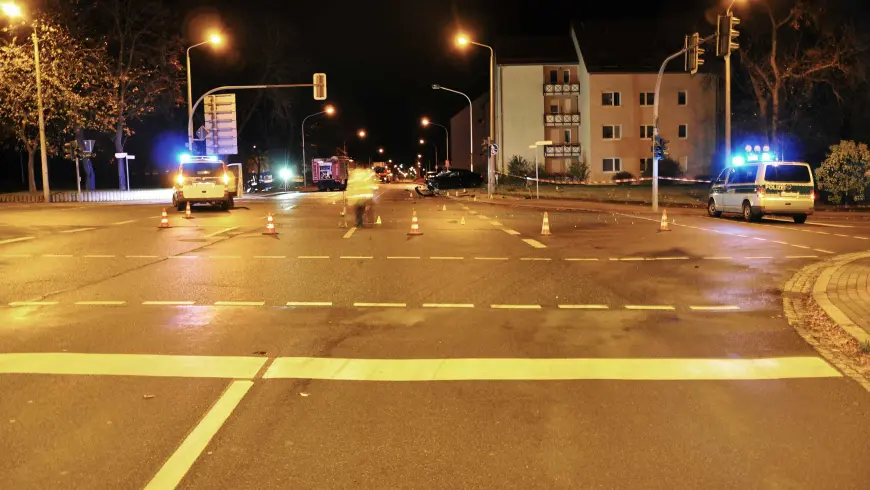Collision at an intersection
Speeding in a built-up area
Sequence of events:
A 21-year-old driver of a car (1) was driving through a built-up area in darkness along a rain-drenched road with right of way, and was speeding. At an intersection, the car collided with another car (2) approaching from the left that wanted to cross the road with right of way. The light signal system at the intersection was off at that time of day, and was therefore flashing amber for the road that did not have right of way. As a result of the violent collision, the front of the car with right of way severely penetrated the side of the crossing car. The rest of the accident comprised the two cars also striking a traffic light post and each other.
A 21-year-old driver of a car (1) was driving through a built-up area in darkness along a rain-drenched road with right of way, and was speeding. At an intersection, the car collided with another car (2) approaching from the left that wanted to cross the road with right of way. The light signal system at the intersection was off at that time of day, and was therefore flashing amber for the road that did not have right of way. As a result of the violent collision, the front of the car with right of way severely penetrated the side of the crossing car. The rest of the accident comprised the two cars also striking a traffic light post and each other.
Persons involved in the accident:
Two car drivers, a passenger
Two car drivers, a passenger
Consequences/injuries:
The driver of car 2 sustained fatal head injuries. The driver and passenger of car 1 sustained minor injuries.
The driver of car 2 sustained fatal head injuries. The driver and passenger of car 1 sustained minor injuries.
Cause/problem:
The accident was caused by the slightly drunk driver of car 2 driving into the intersection despite car 1 approaching from the right having right of way. The driver of car 1 was also traveling far above the speed limit, which the driver of car 2 could not have anticipated. It was not possible to deduce how significantly the driver’s drunk state impacted his misjudgment of speed. Due to the very high collision speed, the passive safety systems installed in car 2 were ineffective in preventing the driver from sustaining fatal injuries.
The accident was caused by the slightly drunk driver of car 2 driving into the intersection despite car 1 approaching from the right having right of way. The driver of car 1 was also traveling far above the speed limit, which the driver of car 2 could not have anticipated. It was not possible to deduce how significantly the driver’s drunk state impacted his misjudgment of speed. Due to the very high collision speed, the passive safety systems installed in car 2 were ineffective in preventing the driver from sustaining fatal injuries.
Avoidance measures, mitigation of consequences/
strategy for road safety measures: If the driver of car 1 had been keeping to the speed limit when car 2 drove across the intersection, the collision would have, at best, been minimal when the emergency stop was carried out. Instead of the fatal injuries, there would have been no notable physical injuries. As it is difficult to assess whether a person’s character is suitable for driving a car when they complete their driver training, the authorities should be allowed to take further measures earlier on with respect to withdrawing the driver’s license off someone who has violated good driving standards. The accident could also have been prevented if the driver of car 2 had acknowledged car 1 with right of way and crossed the intersection at a later point. Even though it is not possible to assess the impact of the low level of alcohol consumed by car driver 2, alcohol should never be consumed before getting behind the wheel.
strategy for road safety measures: If the driver of car 1 had been keeping to the speed limit when car 2 drove across the intersection, the collision would have, at best, been minimal when the emergency stop was carried out. Instead of the fatal injuries, there would have been no notable physical injuries. As it is difficult to assess whether a person’s character is suitable for driving a car when they complete their driver training, the authorities should be allowed to take further measures earlier on with respect to withdrawing the driver’s license off someone who has violated good driving standards. The accident could also have been prevented if the driver of car 2 had acknowledged car 1 with right of way and crossed the intersection at a later point. Even though it is not possible to assess the impact of the low level of alcohol consumed by car driver 2, alcohol should never be consumed before getting behind the wheel.





